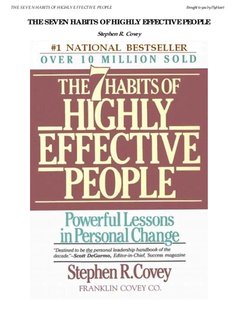‘Seven Habits Of Highly Effective People’ PDF Quick download link is given at the bottom of this article. You can see the PDF demo, size of the PDF, page numbers, and direct download Free PDF of ‘Seven Habits Of Highly Effective People’ using the download button.
The Seven Habits Of Highly Effective People PDF Free Download

Seven Habits Of Highly Effective People
Perhaps the most important insight to be gained from the perception demonstration is in the area of paradigm-shifting, what we might call the “Ahal” experience when someone finally “sees” the composite picture in another way.
The more bound a person is by the initial perception, the more powerful the “Aha!” experience is. It’s as though a light was suddenly turned on inside.
The term Paradigm Shift was introduced by Thomas Kuhn in his highly influential landmark book, The Structure of Scientific Revolutions.
Kuhn shows how almost every significant breakthrough in the field of scientific endeavor is first a break with tradition, with old ways of thinking, with old paradigms.
For Ptolemy, the great Egyptian astronomer, the earth was the center of the universe. But Copernicus created a Paradigm Shift, and a great deal of resistance and persecution as well, by placing the sun at the center.
Suddenly, everything took on a different interpretation. The Newtonian model of physics was a dockworker paradigm and is still the basis of modern engineering.
But it was partial, incomplete The scientific world was revolutionized by the Einsteinian paradigm, the relativity paradigm, which had much higher predictive and explanatory value.
Until the germ theory was developed, a high percentage of women and children died during childbirth, and one could understand why.
In military skirmishes, more men were dying from small wounds and diseases than from the major traumas on the front lines.
But as soon as the germ theory was developed, a whole new paradigm, a better, improved way of understanding what was happening made dramatic, significant medical improvement possible.
The United States today is the fruit of a Paradigm Shift. The traditional concept of government for centuries had been a monarchy, the divine right of kings.
The character ethic taught that there are basic principles of effective living, and that people can only experience true success and enduring happiness as they learn and integrate these principles into their basic character.
But shortly after World War I the basic view of success shifted from the character ethic to what we might call the personality ethic.
Success became more a function of personality, of public image, of attitudes and behaviors, skills and techniques, that lubricate the processes of human interaction.
This personality ethic essentially took two paths: one was human and public relations techniques, and the other was positive mental attitude (PMA).
Some of this philosophy was expressed in inspiring and sometimes valid maxims such as “Your attitude determines your altitude,” “Smiling wins more friends than frowning,” and “Whatever the mind of man can conceive and believe it can achieve.
Other parts of the personality approach were clearly manipulative, even deceptive, encouraging people to use techniques to get other people to I ike them, or to fake interest in the hobbies of others to get out of them what they wanted, or to use the “power look,” or to inti mi date their way through life.
Some of this literature acknowledged character as an ingredient of success, but tended to compartmentalize it rather than recognize it as foundational and catalytic.
Reference to the character ethic became mostly lip service; the basic thrust was quick-fix influence techniques, power strategies, communication skills, and positive attitudes.
This personality ethic, I began to realize, was the subconscious source of the solutions Sandra and I were attempting to use with our son.
As I thought more deeply about the difference between the personality and character ethics, I realized that Sandra and I had been getting social mileage out of our children’s good behavior, and, in our eyes, this son simply didn’t measure up.
Our image of ourselves, and our role as good, caring parents was even deeper than our image of our son and perhaps influenced it.
There was a lot more wrapped up in the way we were seeing and handling the problem than our concern for our son’s welfare.
As Sandra and I talked, we became painfully aware of the powerful influence of our character and motives and of our perception of him.
We knew that social comparison motives were out of harmony with our deeper values and could lead to conditional love and eventually to our son’s lessened sense of self-worth.
So we determined to focus our efforts on us — not on our techniques, but on our deepest motives and our perception of him.
Instead of trying to change him, we tried to stand apart — to separate us from him — and to sense his identity, individuality, separateness, and worth.
Through deep thought and the exercise of faith and prayer, we began to see our son in terms of his own uniqueness.
We saw within him layers and layers of potential that would be realized at his own pace and speed.
We decided to relax and get out of his way and let his own personality emerge. We saw our natural role as being to affirm, enjoy, and value him.
We also conscientiously worked on our motives and cultivated internal sources of security so that our own feelings of worth were not dependent on our children’s “acceptable” behavior.
| Writer | Stephen R Covey |
| Language | English |
| Pages | 172 |
| Pdf Size | 1.37 MB |
| Category | Self Improvement |
The 7 Habits Of Highly Effective People Pdf Free Download
